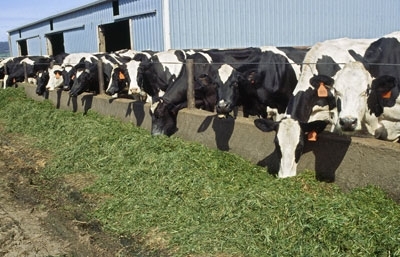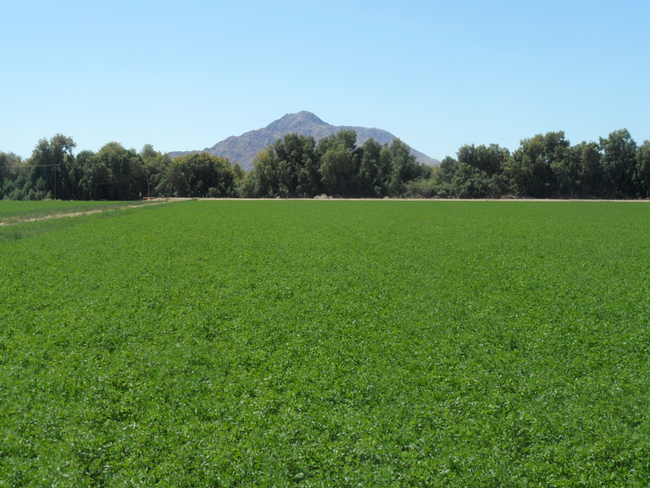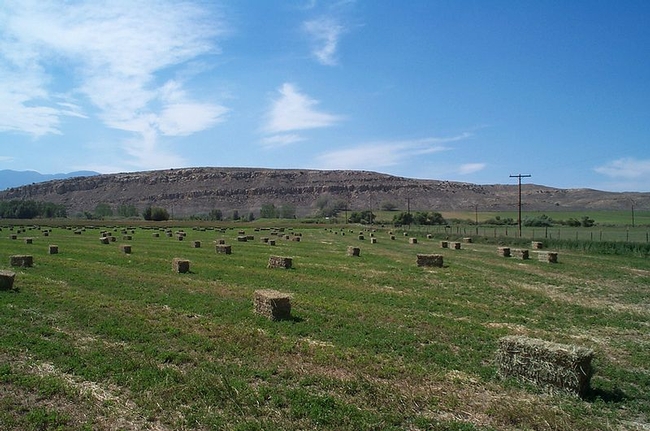Posts Tagged: Alfalfa
The blue alfalfa aphid: A continuing problem into 2015
Basic background and biology of the blue alfalfa aphid: The blue alfalfa aphid (Acyrthosiphon kondoi Shinji) was first identified by entomologists...
UC ANR clarifies drought misconceptions
In two recent broadcast media stories, UC Agriculture and Natural Resources experts were able to provide accurate information about the water use on commodities that have been criticized for water consumption during the drought.
The director of UC ANR's Agricultural Issues Center, Daniel Sumner, was one of three guests on the one-hour talk radio program Your Call, which was broadcast on KALW, Local Public Radio in San Francisco. The topic - How would reducing our intake of meat and dairy affect the drought? - was prompted by off-the-cuff comments made by Gov. Jerry Brown in June. Answering the question, "Is part of the drought strategy to reduce meat consumption?" Brown replied, "If you ask me, I think you should be eating veggie burgers."
On the Your Call show, Sumner explained that beef consumption has little impact on the California drought.
"I do want to make clear, when it comes to water embedded in any product, it depends where the water is from," Sumner said. "We feed cattle in California with grain from the Midwest."
Dairy production is another issue. "Dairy cows are fed lots of grain, soybeans and canola coming from Canada and the Midwest, but also silage and alfalfa, much of which is from California. California dairy is a drought water issue. Beef really isn't."
UC ANR Cooperative Extension specialist Dan Putnam appeared on the KTVU Evening News to discuss alfalfa water use with reporter Ken Wayne. Putnam said the drought has hurt the state's alfalfa industry.
"Statewide, it's been fairly devastating," Putnam said. "We're at the lowest acreage we've seen probably since the 1930s."
He also noted the importance of the crop, a key part of dairy cattle's diets.
"An average field of alfalfa produces approximately 2,400 gallons of milk per acre," Putnam said.
Drip irrigation in alfalfa cuts water use, but isn't for everybody
The drought is forcing farmers to reexamine the way they water their crops, but converting to drip irrigation in alfalfa is unlikely to be widely implemented, reported David Wagner on KPBS Radio News.
The drip irrigation system conserves water - almost by half, said farmer Jack Cato - but is expensive and requires regular maintenance. After six years, the drip system is yet to pay for itself.
"Drip irrigation is not the answer for everything," said Khaled Bali, irrigation advisor with UC Agriculture and Natural Resources (UC ANR). "I would not recommend switching every acre in the Imperial Valley to drip irrigation."
Cato added that new drip irrigation users face a steep learning curve.
"Whatever farm starts doing this, he needs to take baby steps," Cato said. "It's not something you learn overnight, or in a book. You have to study your fields daily."
For more on water use and alfalfa, see Why alfalfa is the best crop to have in the drought by Daniel Putnam, UC ANR Cooperative Extension specialist based at UC Davis, in the Alfalfa & Forage Blog.
New GMO alfalfa holds exciting possibilities, UC expert says
Good news for dairy cows. Science has found a way to produce alfalfa with less lignin, a component of the plant that has no nutritional value. The new alfalfa variety – genetically modified in a way that puts brakes on the lignin-producing gene – was deregulated by USDA in November.
“In general, a reduced lignin trait in alfalfa is very welcome,” said Dan Putnam, UC Cooperative Extension specialist in the Department of Plant Sciences at UC Davis. “The low-lignin trait has some interesting potential implications for dairy cows and other ruminants, as well as for yield, agronomic efficiency, and even energy and water use efficiency.”
The new variety, called KK179, was developed by Forage Genetics International, Monsanto and the Nobel Foundation. Some of the field testing took place at UC Davis and the UC Intermountain Research and Extension Center in Tulelake, Calif.
KK179 differs from most other GMO agricultural crops in that the modification improves the plant quality. Other common modifications, such as glyphosate resistance and addition of a Bt gene, were designed to help with pest control.
Another difference is the source of the modified gene, Putnam said. In glyphosate-resistant (Roundup Ready) alfalfa, for example, the plant was modified by inserting a bacteria gene. Gene segments reducing lignin were derived from alfalfa itself.
Lignin is a fibrous part of cell walls in plants. It strengthens stems, helping the plant grow upright. However, its concentration in alfalfa is high compared to other forages, a drawback for what is considered the premiere forage of dairy cows.
“Farmers often try to cut early to reduce lignin,” Putnam said. “Unfortunately, yields are decreased by early cutting, often by many tons per acre. If growers were able to harvest later and still obtain good quality, yields would improve.”
That leads to the potential energy- and water-conserving aspects of the KK179 alfalfa.
“If growers reduce harvests by one each year and increase yields with no quality penalty, energy use would decline,” Putnam said. “Also, the amount of milk produced per unit of water used to grow the feed may be increased.”
KK179 won't be for everybody, Putnam cautions. Some export markets reject GMO technology, so growers should check whether their markets will accept alfalfa with the low-lignin trait. Another concern is the possibility of gene flow for farmers who grow alfalfa seed for organic production or export.
“Further research and experience by farmers and researchers are needed to fully understand the importance and implications of reduced-lignin alfalfa on farms,” Putnam said, “but this trait holds some very exciting possibilities.”
An initiative to enhance competitive and sustainable food systems is part of the UC Division of Agriculture and Natural Resources Strategic Vision 2025
The Blue Alfalfa Aphid: A continuing problem
The blue alfalfa aphid, Acyrthosiphon kondoi Shinji was first identified by entomologists in the spring of 1975 in the Imperial Valley...




